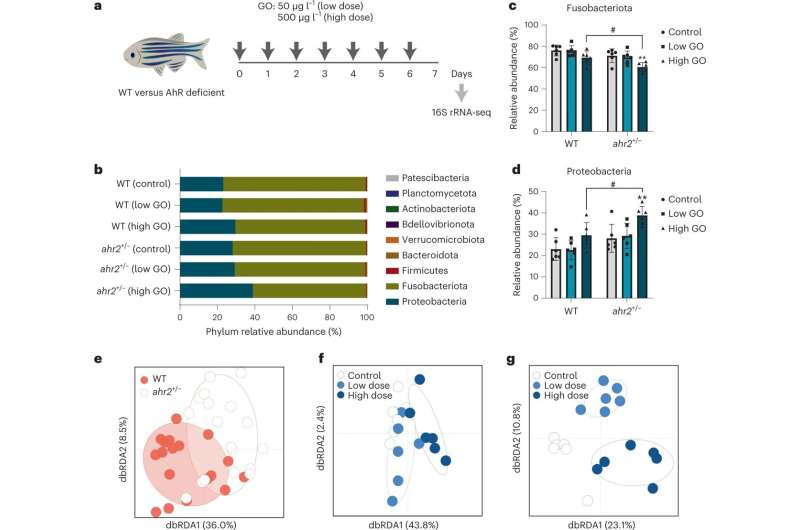
[ad_1]

The nanomaterial graphene oxide—which is utilized in every thing from electronics to sensors for biomolecules—can not directly have an effect on the immune system through the intestine microbiome, as proven in a brand new research on zebrafish by researchers at Karolinska Institutet in Sweden. The findings are reported within the journal Nature Nanotechnology.
“This exhibits that we should issue the intestine microbiome into our understanding of how nanomaterials have an effect on the immune system,” says the paper’s corresponding writer Bengt Fadeel, professor on the Institute of Environmental Drugs, Karolinska Institutet. “Our outcomes are vital for figuring out the potential opposed results of nanomaterial and mitigating or stopping such results in new supplies.”
Graphene is a particularly skinny materials, 1,000,000 occasions thinner than a human hair. It includes a single layer of carbon atoms and is stronger than metal but versatile, clear, and electrically conductive. This makes it extraordinarily helpful in a mess of functions, together with in “sensible” textiles geared up with wearable electronics and as a element of composite supplies, to reinforce the power and conductivity of current supplies.
With the elevated use of graphene-based nanomaterials comes a necessity to look at how these new supplies have an effect on the physique. Nanomaterials are already identified to affect on the immune system, and some research lately have proven that they’ll additionally have an effect on the intestine microbiome, the micro organism that naturally happen within the gastrointestinal tract.
The connection between nanomaterial, intestine microbiome and immunity has been the topic of the current research carried out utilizing zebrafish. The nanomaterial investigated was graphene oxide, which might be described as a relative of graphene that consists of carbon atoms together with atoms of oxygen. In contrast to graphene, graphene oxide is soluble in water and of curiosity to medical analysis as, for instance, a method of delivering medication within the physique.
Within the research, the researchers uncovered grownup zebrafish to graphene oxide through the water and analyzed the way it impacts the composition of the microbiome. They used each regular fish and fish missing a receptor molecule of their intestinal cells referred to as the aryl hydrocarbon receptor, generally abbreviated as AhR, a receptor for numerous endogenous and bacterial metabolites.
“We had been capable of present that the composition of the intestine microbiome modified once we uncovered the fish to graphene oxide, even at a low dose, and that the AhR additionally affected the intestine microbiome,” says the research’s first writer Guotao Peng, postdoc researcher on the Institute of Environmental Drugs at Karolinska Institutet.
The researchers have additionally generated zebrafish larvae that fully lack a pure intestine microbiome, which makes it doable to check the results of particular person microbiome elements, on this case butyric acid (a fatty acid), which is secreted by sure sorts of intestine micro organism. Butyric acid is understood to have the ability to bind to AhR.
Doing this, the researchers discovered that the mixture of graphene oxide and butyric acid gave rise to so-called kind 2 immunity within the fish. The impact turned out to be depending on the expression of AhR within the intestinal cells.
“This sort of immunity is often seen as a response to parasitic an infection. Our interpretation is that the intestine immune response can deal with graphene oxide in an identical method to how it could deal with a parasite,” says Guotao Peng.
Utilizing a complicated methodology for mapping the immune cells, the researchers had been additionally capable of present {that a} element of the immune system referred to as innate lymphoid cells are present in zebrafish larvae.
“This exhibits that the zebrafish is an efficient mannequin for finding out the immune system, together with the primitive or innate immune system,” says Bengt Fadeel.
Extra info:
Bengt Fadeel, Graphene oxide elicits microbiome-dependent kind 2 immune responses through the aryl hydrocarbon receptor, Nature Nanotechnology (2022). DOI: 10.1038/s41565-022-01260-8. www.nature.com/articles/s41565-022-01260-8
Supplied by
Karolinska Institutet
Quotation:
Nanomaterial influences intestine microbiome and immune system interactions (2022, December 12)
retrieved 12 December 2022
from https://phys.org/information/2022-12-nanomaterial-gut-microbiome-immune-interactions.html
This doc is topic to copyright. Aside from any truthful dealing for the aim of personal research or analysis, no
half could also be reproduced with out the written permission. The content material is offered for info functions solely.
[ad_2]